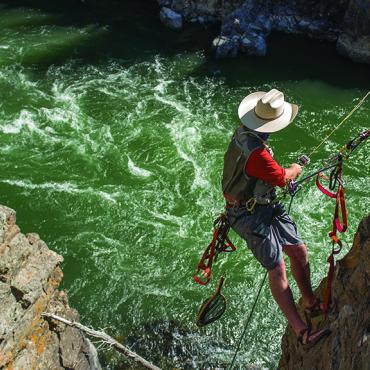Hand-to-Hoof Combat
Catch-and-release hunting takes off.
No guns. No bows. No spears, knives, or clubs. This is hunting at its most primeval, pitting man against beast without the aid of technology. No weapons are allowed—it’s hand versus hoof, head versus horn.
It is both the oldest and newest form of hunting, using modern combat techniques popularized by the UFC, and celebrating the challenge of battle, rather than the kill. And while their freezers may remain empty, members of the Mixed Martial Arts Hunters of America (MMAHA) aren’t without reward.
The aim of MMAHA (pronounced ma-HA!, with gusto) is to promote the burgeoning sport of non-lethal, weaponless, catch-and-release hunting in the United States. Yes, it sounds idiotic. No, it’s not sanctioned, by the UFC, WWE, or FWP. But it is totally different from any other form of hunting. The idea is for hunters to stalk their prey to within physical grasp, fight that prey into submission using a smorgasbord of hand-to-hand combat techniques (such as jiu-jitsu, kickboxing, taekwondo, karate, judo, and boxing), then release the prey back into the wild unharmed. Simple. Elegant. Awesome. And dangerous as hell.
The organization started with Herbert “Herbie” Voer; a diesel mechanic, native Montanan, and strict vegetarian. “I’ve always loved to fight, and of course I felt left out when my buddies went huntin’ without me,” he explains. “Just because I don’t eat meat doesn’t mean I don’t have the same predatory instinct as the next guy.” But he got tired of people bragging about 600-yard shots with sniper rifles. “Hunters who can’t get within a half-mile of their prey are a bunch of sissies,” he says. “You wanna be badass? Get within half a foot! Stalk and wrestle that 250-pound muley to the ground and choke it or bend its leg until it just plain gives up. Now that’s sport. That’s what MMAHA’s all about.”
It’s also sustainable—a deer may be a bit sore after an intense bout, but no worse for the wear (if all goes well, the same holds true for the hunter). This has attracted vegetarians like Herbie, but also well-known naturalists, Buddhists, and Californians, for whom killing game is considered far too deadly. Putting a pissed-off deer in a headlock is also a heck of a workout and has begun to catch on among the legions of CrossFit lovers, for whom flipping giant tires has become, well, tiresome.
Catch-and-release rules are strict: hunters must locate animals using fair means (no baiting, drones, trail cameras, etc.), the animal must be free-ranging (no trapping, snaring, or corralling), and once the battle is on, fishhooking, eye-gouging, and crotch-kicking are forbidden—just like in human MMA. “We’re all about a fair fight,” says Herbie. “Mano a muley.” For this reason, only neophyte whitebelts are allowed to square off with yearlings or old, diseased animals. “We had a jiu-jitsu blackbelt once who took down a spotted fawn,” Herbie says, his face trembling with rage at the memory. “Real prick, that guy. He put the poor critter in a guillotine hold, with the mother watching!”
When a deer is successfully wrestled to submission (it is unable to move and appears to give up), MMAHA ethics dictate an immediate and complete release. Most times, the animal will shake it off and run away, ashamed of its bitter defeat at the hands of a clumsy biped. But from time to time, a rutting buck may demand a rematch, and it is the hunter’s responsibility to accept. “When they’re fired up and snortin’ mad at having been bested,” says Herbie, “that’s when it gets dangerous—and excitin’!”
Not everyone approves of non-lethal hunting, however. People for the Ethical Tolerance of Animals (PETA) is naturally skeptical, and has begun training Montana deer in the martial arts in order to level the playing field. PETA encourages its members to referee matches, to ensure fairness and sportsmanlike conduct. Traditional hook-and-bullet organizations are also on the fence: Backwoods Hunters and Anglers calls the sport “confusing, confounding, and concerning.” But Herbie and his small membership just laugh as they lace up their headgear, tape their knuckles, and step into the woods.
Most MMAHA hunters start with white-tailed deer—they’re smaller and more agreeable than mule deer, and easier to approach than antelope. Mule deer represent a step up in weight class—a large buck can tip the scales at nearly 300 pounds, and wield larger antlers. To date, no one has successfully grappled a bull elk into submission, though two hunters have lost their lives in the pursuit of this ultimate title bout. These deaths were felt deeply by MMAHA, Herbie explains, since they represented one third of the nation’s total membership. “A bull submission is the ultimate goal—it’s our Rubicon,” Herbie says, “but it’s gonna take a hell of a fighter. You gotta have huge marbles to square off with 800 pounds of raw, antlered aggression, I tell ya.”
Herbie’s advice for novice MMAHA hunters? “Practice your takedowns—your single leg, double leg, and heck even your triple and quad leg takedowns. Once he’s on the ground, you got options: arm bars, hammer fists, rear naked chokes—even headbutting, if you want to get ironic with it.” But the most important thing? “Be a good sportsman out there. As much as it’s about kicking ass, it’s also about feeling close to nature. Real, real close.”

















